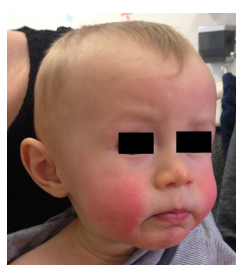Parvovirus
Specifically, Human Parvovirus B19. Small, non-enveloped negative strand DNA virus similar to Adenovirus.
Has an incubation period of 4-14 days. Prolonged shedding is possible in immunocompromised patients. After the formation of antigen-antibody immune complexes, hosts are no longer infectious.
Cellular Targets
Transmitted through contact with respiratory droplets, transfusions with infected blood, or from mother to fetus during pregnancy. The virus targets erythroid precursor cells leading to inhibition of erythrocyte production, destruction of reticulocytes, and erythrolysis.
Clinical Features
Five distinct syndromes. Most cases will experience mild flu-like symptoms (fever, malaise, myalgia) or be completely asymptomatic.
Erythema Infectiosum (Fifth Disease)
Common childhood exanthem (skin rash associated with systemic infection). The classic presentation is described as a "slapped cheek" rash across the face. It's a shame this looks so cute.

Arthritis (Polyarthropathy Syndrome)
Inflammation of the joints due to direct infection or formation of antigen-antibody immune complexes. This is non-erosive, so joint cartilage and architecture are not destroyed. More common in females.
Transient Aplastic Anemia
Self-limited anemia that typically resolves within 1-2 weeks. Seen in individuals with pre-existing hematologic disease (e.g., sickle cell anemia, iron-deficiency anemia, spherocytosis). Symptoms include severe anemia and lethargy.
Pure Red Cell Aplasia
Immunocompromised patients cannot clear the virus from the body. This leads to persistent infection attacking red blood cells, resulting in chronic anemia.
Fetal Infection
- Severe anemia: Hypoxia and heart failure
- Hydrops fetalis: Non-immune disease that can develop secondary to infection and anemia. Presents with anasarca (generalized edema).
Diagnosis
Made clinically without serologic testing, especially if the patient displays classic presentation of the malar rash.
Management
The majority of cases are self-limited. Treatment is generally supportive.
More severe cases involving aplastic anemia may require blood transfusions or stem cell transplant.